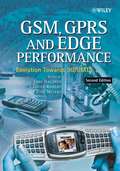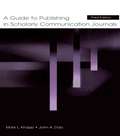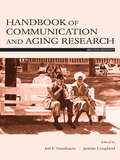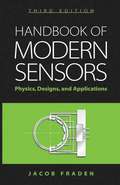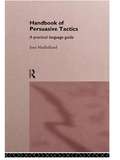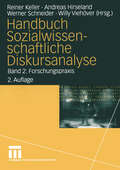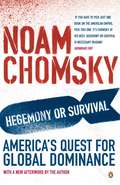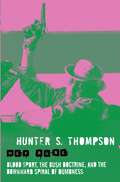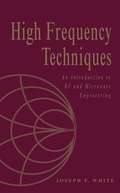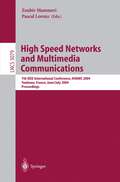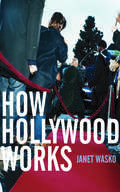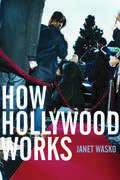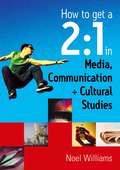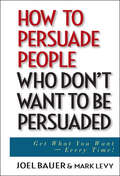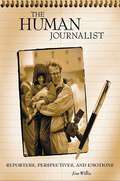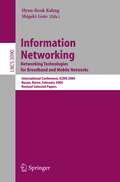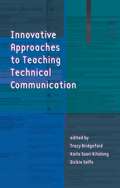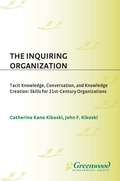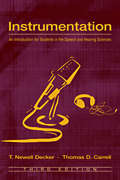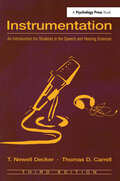- Table View
- List View
GSM, GPRS and EDGE Performance: Evolution Towards 3G/UMTS
by Timo Halonen Javier Romero Juan MeleroGSM, GPRS and EDGE Performance - Second Edition provides a complete overview of the entire GSM system. GSM (Global System for Mobile Communications) is the digital transmission technique widely adopted in Europe and supported in North America. It features comprehensive descriptions of GSM’s main evolutionary milestones - GPRS, (General Packet Radio Services) is a packet-based wireless communication service that promises data rates from 56 up to 114 Kbps and continuous connection to the Internet for mobile phone and computer users. AMR and EDGE (Enhanced Data GSM Environment), and such developments have now positioned GERAN (GSM/EDGE Radio Access Network) as a full 3G radio standard. The radio network performance and capabilities of GSM, GPRS, AMR and EDGE solutions are studied in-depth by using revealing simulations and field trials. Cellular operators must now roll out new 3G technologies capable of delivering wireless Internet based multimedia services in a competitive and cost-effective way and this volume, divided into three parts, helps to explain how: 1. Provides an introduction to the complete evolution of GSM towards a radio access network that efficiently supports UMTS services (GERAN). 2. Features a comprehensive study of system performance with simulations and field trials. Covers all the major features such as basic GSM, GPRS, EDGE and AMR and the full capability of the GERAN radio interface for 3G service support is envisaged. 3. Discusses different 3G radio technologies and the position of GERAN within such technologies. Featuring fully revised and updated chapters throughout, the second edition contains 90 pages of new material and features the following new sections, enabling this reference to remain as a leading text in the area: Expanded material on GPRS Includes IMS architecture (Rel’5) and GERAN (Rel’6) features Presents field trial results for AMR and narrowband Provides EGPRS deployment guidelines Features a new chapter on Service Performance An invaluable reference for Engineering Professionals, Research and Development Engineers, Business Development Managers, Technical Managers and Technical Specialists working for cellular operators
A Guide to Publishing in Scholarly Communication Journals (Published for the International Communication Association)
by Mark L. Knapp John A. DalyThis guide offers detailed advice on the journal article publication process, describing each step of the process and providing insights for improving the presentation of work intended for publication in communication journals. It includes advice from journal editors across the discipline and offers resource materials to help both new and seasoned writers publish their work. The guide begins with an overview of the publication process, followed by a discussion of each step of the manuscript submission, review, and revision processes. In addition to reality-based answers to questions often posed to editors, resource materials are provided in the appendices, introducing readers to the various forms and correspondence they will encounter when they submit their work for consideration. The guide focuses on the issues and procedures associated with the publication process, examining rules and expectations encountered during the publishing process that are often assumed to be known but are rarely articulated. The guidance provided here will aid in establishing consistency in publication practices and will contribute toward improving the quality of journal submissions, as well as enhancing interaction with editors and reviewers. As a guide to demystifying procedures associated with the publication process, this resource will serve all academic authors desiring to publish their work in scholarly communication journals.
A Guide to Publishing in Scholarly Communication Journals (Published for the International Communication Association)
by Mark L. Knapp John A. DalyThis guide offers detailed advice on the journal article publication process, describing each step of the process and providing insights for improving the presentation of work intended for publication in communication journals. It includes advice from journal editors across the discipline and offers resource materials to help both new and seasoned writers publish their work. The guide begins with an overview of the publication process, followed by a discussion of each step of the manuscript submission, review, and revision processes. In addition to reality-based answers to questions often posed to editors, resource materials are provided in the appendices, introducing readers to the various forms and correspondence they will encounter when they submit their work for consideration. The guide focuses on the issues and procedures associated with the publication process, examining rules and expectations encountered during the publishing process that are often assumed to be known but are rarely articulated. The guidance provided here will aid in establishing consistency in publication practices and will contribute toward improving the quality of journal submissions, as well as enhancing interaction with editors and reviewers. As a guide to demystifying procedures associated with the publication process, this resource will serve all academic authors desiring to publish their work in scholarly communication journals.
Handbook of Communication and Aging Research
by Jon F. Nussbaum Justine CouplandThis second edition of the Handbook of Communication and Aging Research captures the ever-changing and expanding domain of aging research. Since it was first recognized that there is more to social aging than demography, gerontology has needed a communication perspective. Like the first edition, this handbook sets out to demonstrate that aging is not only an individual process but an interactive one. The study of communication can lead to an understanding of what it means to grow old. We may age physiologically and chronologically, but our social aging--how we behave as social actors toward others, and even how we align ourselves with or come to understand the signs of difference or change as we age--are phenomena achieved primarily through communication experiences.Synthesizing the vast amount of research that has been published on communication and aging in numerous international outlets over the last three decades, the book's contributors include scholars from North America and the United Kingdom who are active researchers in the perspectives covered in their particular chapter. Many of the chapters work to deny earlier images of aging as involving normative decrement to provide a picture of aging as a process of development involving positive choices and providing new opportunities. A recuring theme in many chapters is that of the heterogeneity of the group of people who are variously categorized as older, aged, elderly, or over 65. The contributors review the literature analytically, in a way that reveals not only current theoretical and methodological approaches to communication and aging research but also sets the future agenda.This handbook will be of great interest to scholars and researchers in gerontology, developmental psychology, and communication, and, in this updated edition, will continue to play a key role in the study of communication and aging.
Handbook of Communication and Aging Research
by Jon F. Nussbaum Justine CouplandThis second edition of the Handbook of Communication and Aging Research captures the ever-changing and expanding domain of aging research. Since it was first recognized that there is more to social aging than demography, gerontology has needed a communication perspective. Like the first edition, this handbook sets out to demonstrate that aging is not only an individual process but an interactive one. The study of communication can lead to an understanding of what it means to grow old. We may age physiologically and chronologically, but our social aging--how we behave as social actors toward others, and even how we align ourselves with or come to understand the signs of difference or change as we age--are phenomena achieved primarily through communication experiences.Synthesizing the vast amount of research that has been published on communication and aging in numerous international outlets over the last three decades, the book's contributors include scholars from North America and the United Kingdom who are active researchers in the perspectives covered in their particular chapter. Many of the chapters work to deny earlier images of aging as involving normative decrement to provide a picture of aging as a process of development involving positive choices and providing new opportunities. A recuring theme in many chapters is that of the heterogeneity of the group of people who are variously categorized as older, aged, elderly, or over 65. The contributors review the literature analytically, in a way that reveals not only current theoretical and methodological approaches to communication and aging research but also sets the future agenda.This handbook will be of great interest to scholars and researchers in gerontology, developmental psychology, and communication, and, in this updated edition, will continue to play a key role in the study of communication and aging.
Handbook of Modern Sensors: Physics, Designs, and Applications
by Jacob FradenSeven years have passed since the publication of the previous edition of this book. During that time, sensor technologies have made a remarkable leap forward. The sensitivity of the sensors became higher, the dimensions became smaller, the sel- tivity became better, and the prices became lower. What have not changed are the fundamental principles of the sensor design. They are still governed by the laws of Nature. Arguably one of the greatest geniuses who ever lived, Leonardo Da Vinci, had his own peculiar way of praying. He was saying, “Oh Lord, thanks for Thou do not violate your own laws. ” It is comforting indeed that the laws of Nature do not change as time goes by; it is just our appreciation of them that is being re?ned. Thus, this new edition examines the same good old laws of Nature that are employed in the designs of various sensors. This has not changed much since the previous edition. Yet, the sections that describe the practical designs are revised substantially. Recent ideas and developments have been added, and less important and nonessential designs were dropped. Probably the most dramatic recent progress in the sensor technologies relates to wide use of MEMS and MEOMS (micro-electro-mechanical systems and micro-electro-opto-mechanical systems). These are examined in this new edition with greater detail. This book is about devices commonly called sensors. The invention of a - croprocessor has brought highly sophisticated instruments into our everyday lives.
A Handbook of Persuasive Tactics: A Practical Language Guide
by Joan MulhollandMost people have to communicate with colleagues every day and persuade them to understand their opinions or to accept their views. This handbook is intended for anyone who is interested in such goal-oriented language. It extracts 300 persuasive tactics from research findings in communication, linguistics, pragmatics and related fields, and presents them in a clear, concise and consistent manner. Such tactics as analogy, argument presentation, humour and metaphor are included. Each tactic is presented on a separate page with an analysis of its persuasive value. Two indexes - one by persuasive need and the other by tactic - allow readers full flexibility to use the handbook in their own way. This work should be of interest in courses which deal with the management of interaction, pragmatics, discourse analysis and communications.
A Handbook of Persuasive Tactics: A Practical Language Guide
by Joan MulhollandMost people have to communicate with colleagues every day and persuade them to understand their opinions or to accept their views. This handbook is intended for anyone who is interested in such goal-oriented language. It extracts 300 persuasive tactics from research findings in communication, linguistics, pragmatics and related fields, and presents them in a clear, concise and consistent manner. Such tactics as analogy, argument presentation, humour and metaphor are included. Each tactic is presented on a separate page with an analysis of its persuasive value. Two indexes - one by persuasive need and the other by tactic - allow readers full flexibility to use the handbook in their own way. This work should be of interest in courses which deal with the management of interaction, pragmatics, discourse analysis and communications.
Handbuch Fernsehforschung: Befunde und Perspektiven
by Klaus PlakeDas Lehrbuch bietet einen Überblick zu den wichtigsten Arbeiten, die sich mit dem Medium Fernsehen befassen. Bislang disparat erscheinende Untersuchungsgebiete wie z.B. Gattungen und Genres von TV-Programmen, Einstellungen und Strukturen der Zuschauer, die Unternehmensorganisation der TV-Anbieter, rechtliche Bestimmungen sowie politische Voraussetzungen und Folgen des Fernsehens erscheinen so in einem Zusammenhang, der die Eigenarten des Mediums deutlich macht und allen Interessierten einen schnellen Zugriff auf kompakte Information bietet.
Handbuch Sozialwissenschaftliche Diskursanalyse: Band 2: Forschungspraxis
by Reiner Keller Andreas Hirseland Werner Schneider Willy ViehöverDer zweite Band des Handbuches stellt in Einzelbeiträgen aus unterschiedlichen Disziplinen exemplarische Vorgehensweisen der Diskursforschung vor. Er wendet sich an Studierende und WissenschaftlerInnen, die sich mit der Diskursanalyse vertraut machen wollen. Der erste Teilband präsentiert theoretische Grundlagen und allgemeine methodische Zugänge unterschiedlicher Ansätze der Diskursforschung. Der zweite Teilband versammelt in 15 Einzelbeiträgen exemplarische diskursanalytische Studien aus Soziologie, Geschichts- und Politikwissenschaft, Diskursiver Psychologie, Kritischer Diskursanalyse, linguistischer Diskursgeschichte und Korpuslinguistik. Im Vordergrund stehen nicht die jeweiligen Fragestellungen der Einzeluntersuchungen, sondern der Zusammenhang von Fragestellung, empirischem Design, Detailanalyse und Formulierung des Gesamtergebnisses. Die Erläuterung des methodischen Vorgehens an Beispielen eignet sich für den Einsatz in der Lehre wie für die Orientierung in Bezug auf Planung und Durchführung eigener Forschungsprojekte.
Hegemony or Survival: America's Quest for Global Dominance (American Empire Project Ser. #Vol. 185)
by Noam ChomskyHegemony or Survival is Noam Chomsky's essential polemic on American foreign policy.Noam Chomsky, the world's foremost intellectual activist, presents an irrefutable analysis of America's pursuit of total domination and the catastrophic consequences that are sure to follow.From the funding of repressive regimes to the current 'war on terror', from the toppling of governments opposing its beliefs to the invasion of Iraq, America pursues its global strategy no matter what the cost. With the rigour and insight that have made him our most important unraveller of accredited lies, Noam Chomsky reveals the truth and the true motives behind America's quest for dominance - and seeks also to show how the world may yet step back from the brink.'A devastating history of American foreign policy since 1945 as well as a dissection of the current "war on terror"' Tim Adams, Observer'Anybody who thinks about American foreign policy has to read and contemplate Hegemony or Survival' Independent'One of the radical heroes of our age. A towering intellect' GuardianNoam Chomsky is the author of numerous bestselling political books, including Hegemony or Survival, Failed States, Interventions, What We Say Goes, Hopes and Prospects, How the World Works and Occupy, all of which are published by Hamish Hamilton/Penguin.
Hey Rube: Blood Sport, the Bush Doctrine, and the Downward Spiral of Dumbness
by Hunter ThompsonFor decades, Hunter S. Thompson galvanized American journalism with his acerbic wit, radical ideas, and gonzo tactics. He continued his reign as ‘the Unabomber of contemporary letters’ (Time) with Hey Rube. Fear, greed, and action abound in this hilarious, thought-provoking compilation as Thompson doles out searing indictments and uproarious rants while providing brilliant commentary on politics, sex, and sports – at times all in the same column. Filled with critics’ favorites, as well as never-before-published columns, Hey Rube follows Thompson through the beginning of the new century. Hey Rube gives us a look at the gonzo journalist in his most organic form – unbridled, astute, and irreverent.
High Frequency Techniques: An Introduction to RF and Microwave Design and Computer Simulation (Wiley - IEEE)
by Joseph F. WhiteThis textbook is an introduction to microwave engineering. The scope of this book extends from topics for a first course in electrical engineering, in which impedances are analyzed using complex numbers, through the introduction of transmission lines that are analyzed using the Smith Chart, and on to graduate level subjects, such as equivalent circuits for obstacles in hollow waveguides, analyzed using Green’s Functions. This book is a virtual encyclopedia of circuit design methods. Despite the complexity, topics are presented in a conversational manner for ease of comprehension. The book is not only an excellent text at the undergraduate and graduate levels, but is as well a detailed reference for the practicing engineer. Consider how well informed an engineer will be who has become familiar with these topics as treated in High Frequency Techniques: (in order of presentation) Brief history of wireless (radio) and the Morse code U.S. Radio Frequency Allocations Introduction to vectors AC analysis and why complex numbers and impedance are used Circuit and antenna reciprocity Decibel measure Maximum power transfer Skin effect Computer simulation and optimization of networks LC matching of one impedance to another Coupled Resonators Uniform transmission lines for propagation VSWR, return Loss and mismatch error The Telegrapher Equations (derived) Phase and Group Velocities The Impedance Transformation Equation for lines (derived) Fano’s and Bode’s matching limits The Smith Chart (derived) Slotted Line impedance measurement Constant Q circles on the Smith Chart Approximating a transmission line with lumped L’s and C’s ABCD, Z, Y and Scattering matrix analysis methods for circuits Statistical Design and Yield Analysis of products Electromagnetic Fields Gauss’s Law Vector Dot Product, Divergence and Curl Static Pot
High Speed Networks and Multimedia Communications: 7th IEEE International Conference, HSNMC 2004, Toulouse, France, June 30- July 2, 2004, Proceedings (Lecture Notes in Computer Science #3079)
by Zoubir Mammeri Pascal LorenzNowadays, networks and telecommunications are two of the most active ?elds. Research and development in these areas have been going on for some time, reaching the stage of products. The objectives of HSNMC 2004 (International Conference on High Speed Networks and Multimedia Communications) were to promote research and development activities and to encourage communication between academic researchers and engineers throughout the world in the areas related to high-speed networks and multimedia communications. The seventh edition of HSNMC was held in Toulouse, France, on June 30– July2,2004. Therewere266submissionstoHSNMCthisyearfrom34countries, which were evaluated by program committee members assisted by external - viewers. Each paper was reviewed by several reviewers. One hundred and one papers were selected to be included in these proceedings. The quality of s- missions was high, and the committee had to decline some papers worthy for publication. The papers selected in this book illustrate the state of the art, current d- cussions, and development trends in the areas of networks, telecommunication and multimedia applications. The contributions published in this book und- line the international importance of the related ?eld of research. They cover a variety of topics, such as QoS in Di?Serv networks, QoS analysis and m- surement, performance modelling, TCP modelling and analysis, MPLS for QoS provision, scheduling and resource allocation, routing, multicast, security and privacy issues, peer-to-peer applications, video applications, software and m- dleware for networks, mobile networks, mobility, satellite, mobile IP, wireless networks, WLAN, ad hoc networks, 3G/UMTS, IEEE 802.
How Hollywood Works
by Janet WaskoThis is a book about the US motion picture industry - its structure and policies, its operations and practices. It looks at the processes that are involved in turning raw materials and labor into feature films. It describes the process of film production, distribution, exhibition and retail - a process that involves different markets where materials, labor and products are bought and sold. In other words, this is a book about how Hollywood works - as an industry. How Hollywood Works: - offers an up-to-date survey of the policies and structure of the US film industry - looks at the relationship between the film industry and other media industries - examines the role of the major studios and the other 'players' - including, law firms, talent agents, and trade unions and guilds - provides access to hard-to-find statistical information on the industry While many books describe the film production and marketing process, they usually do so from an industry perspective and few look at Hollywood critically from within a more general economic, political and social context. By offering just such a critique, Janet Wasko's text provides a timely and essential analysis of how Hollywood works for all students of film and media.
How Hollywood Works (PDF)
by Janet WaskoThis is a book about the US motion picture industry - its structure and policies, its operations and practices. It looks at the processes that are involved in turning raw materials and labor into feature films. It describes the process of film production, distribution, exhibition and retail - a process that involves different markets where materials, labor and products are bought and sold. In other words, this is a book about how Hollywood works - as an industry. How Hollywood Works: - offers an up-to-date survey of the policies and structure of the US film industry - looks at the relationship between the film industry and other media industries - examines the role of the major studios and the other 'players' - including, law firms, talent agents, and trade unions and guilds - provides access to hard-to-find statistical information on the industry While many books describe the film production and marketing process, they usually do so from an industry perspective and few look at Hollywood critically from within a more general economic, political and social context. By offering just such a critique, Janet Wasko's text provides a timely and essential analysis of how Hollywood works for all students of film and media.
How to get a 2:1 in Media, Communication and Cultural Studies (PDF)
by Noel R Williams`This is the most well written book I have read for some time. I would have very much wished for such a book when I was an undergraduate. It outlines very clearly and honestly the skills needed to be a successful independent learner. …the authors "voice" is one of a critical friend that the reader can trust.... It contains lots of good advice in relation to student support and guidance for any future subject review and on how to meet the "skills based" elements of the QAA benchmarks' Shaun Best, University of Manchester How can you succeed in media, communication and cultural studies? What are the best ways to answer essays and exams? How can you sort out your dissertation? This comprehensive and reliable book provides students in these disciplines with all they need to know to maximize their learning experience. The book: · Defines the field · Provides easy tips on being a good learner · Helps them communicate effectively in seminars · Clearly outlines key ideas and thinkers · Supplies a trouble-shooting and problem solving guide for all aspects of their study Written by an experienced lecturer and writer, the book is a must for effective performance on media, communication and cultural studies courses.
How to Persuade People Who Don't Want to be Persuaded: Get What You Want -- Every Time!
by Joel Bauer Mark LevyThe art of persuasion as taught by one of the world's most sought-after speakers and pitchmen In this daring book, Joel Bauer teaches you how to persuade by making your messages entertaining. Learn the secrets behind "The Fright Challenge," "The Transformation Mechanism," and other persuasion tactics used by pitchmen, carneys, and conjurors to convince people to their way of thinking. Along with coauthor Mark Levy, Bauer has taken these ethical, entertainment-based techniques, and has made them practical for everyday use-capable of influencing one person or a thousand, in business and in life. Joel Bauer (Los Angeles, CA) is an expert in performance-based live marketing who The Wall Street Journal online referred to as "undoubtedly the chairman of the board" of corporate tradeshow rain-making. Mark Levy (Chester, NJ) has written for the New York Times, has authored or coauthored three books, and is the founder of Levy Innovation, a consulting firm that makes individuals and companies memorable.
How to Persuade People Who Don't Want to be Persuaded: Get What You Want -- Every Time!
by Joel Bauer Mark LevyThe art of persuasion as taught by one of the world's most sought-after speakers and pitchmen In this daring book, Joel Bauer teaches you how to persuade by making your messages entertaining. Learn the secrets behind "The Fright Challenge," "The Transformation Mechanism," and other persuasion tactics used by pitchmen, carneys, and conjurors to convince people to their way of thinking. Along with coauthor Mark Levy, Bauer has taken these ethical, entertainment-based techniques, and has made them practical for everyday use-capable of influencing one person or a thousand, in business and in life. Joel Bauer (Los Angeles, CA) is an expert in performance-based live marketing who The Wall Street Journal online referred to as "undoubtedly the chairman of the board" of corporate tradeshow rain-making. Mark Levy (Chester, NJ) has written for the New York Times, has authored or coauthored three books, and is the founder of Levy Innovation, a consulting firm that makes individuals and companies memorable.
The Human Journalist: Reporters, Perspectives, and Emotions (Non-ser.)
by Jim WillisWillis examines the many orientations and perspectives of reporters that gather and present the news of the day. Debunking the notion that there are limited perspectives journalists may use, Willis examines up to 15 different orientations that reporters bring to their work. These perspectives run the gamut, from the traditional approach of distancing oneself completely from events and people involved to becoming part of the story's fabric to ascertain the story's true essence.Willis also suggests that, for many stories, it is wholly appropriate for journalists to feel what a non-professional would experience at such an event, and to allow those emotions to fuel the reporting and writing of the story. Several examples are discussed in detail, including the coverage of the bombing of the Alfred P. Murrah Federal Building in Oklahoma City on April 19, 1995, and the terrorist attacks of September 11, 2001.
Information Networking. Networking Technologies for Broadband and Mobile Networks: International Conference ICOIN 2004, Busan, Korea, February 18-20, 2004, Revised Selected Papers (Lecture Notes in Computer Science #3090)
by Hyun-Kook KahngInnovative Approaches to Teaching Technical Communication
by Tracy Bridgeford Karla Saari Kitalong Dickie SelfePrograms in technical writing, technical communication, and/or professional communication have recently grown in enrollment as the demand among employers for formally prepared technical writers and editors has grown. In response, scholarly treatments of the subject and the teaching of technical writing are also burgeoning, and the body of research and theory being published in this field is many times larger and more accessible than it was even a decade ago. Although many theoretical and disciplinary perspectives can potentially inform technical communication teaching, administration, and curriculum development, the actual influences on the field's canonical texts have traditionally come from a rather limited range of disciplines. Innovative Approaches to Teaching Technical Communication brings together a wide range of scholars/teachers to expand the existing canon.
The Inquiring Organization: Tacit Knowledge, Conversation, and Knowledge Creation: Skills for 21st-Century Organizations (Non-ser.)
by Catherine Kikoski John KikoskiThis book provides the context and tools to create knowledge via a proven process of inquiry, questions, and conversation. It introduces the theoretical background to explain why, as well as the practical hands-on skills and processes to demonstrate how, to surface tacit knowledge—that which we know but which we have not yet made explicit in conversation, e.g., background, education, and experience—and create new knowledge in collaboration with colleagues.In the information economy, knowledge is an asset and a currency. The creation of new knowledge, therefore, enhances an organization's position in the marketplace. How do we create new knowledge? We don't do it by learning what is already known. The learning organization is already passé. Instead, we do it by inquirinq, which is a method of bringing tacit knowledge to the forefront of awareneness. The inquiring organization surfaces tacit knowledge, which is what its employees bring to the table—their background, education, experience, character, and judgment—and transforms that knowledge into new, explicit knowledge that can be transferred from one employee to another through conversation. That is true knowledge creation, and this book provides the tools, skills, techniques, and processes for executives and professionals in any field to accomplish this task in today's fluid environment.
Instrumentation: An Introduction for Students in the Speech and Hearing Sciences
by T. Newell Decker Thomas D. CarrellWhile keeping the scope and essential thrust of the original book unchanged, this third edition has been updated to reflect the latest technology. For instance, important revisions have been made to a few chapters, while one chapter has been eliminated and replaced with a newer chapter dealing with recent developments in digital and consumer electronics that are relevant to laboratory instrumentation. The authors hope the readers of this text will be more confident with instrumentation and more willing to experiment with it, as well as be able to appreciate the possible ways that electronic instrumentation can be used in their work. The book was written with the undergraduate in speech and hearing sciences uppermost in mind. Instead of detailed information about individual pieces of instrumentation, a more basic and broad descriptive approach has been used. Throughout, examples have been provided regarding how certain pieces of equipment can be used in the clinic or laboratory. One or more step-by-step exercises are included at the end of certain chapters to help students obtain hands-on experience and equipment flowcharts help reinforce the exercise. Students who complete this book will have a basic understanding of the major pieces of instrumentation in the hearing and speech clinic/laboratory.
Instrumentation: An Introduction for Students in the Speech and Hearing Sciences
by T. Newell Decker Thomas D. CarrellWhile keeping the scope and essential thrust of the original book unchanged, this third edition has been updated to reflect the latest technology. For instance, important revisions have been made to a few chapters, while one chapter has been eliminated and replaced with a newer chapter dealing with recent developments in digital and consumer electronics that are relevant to laboratory instrumentation. The authors hope the readers of this text will be more confident with instrumentation and more willing to experiment with it, as well as be able to appreciate the possible ways that electronic instrumentation can be used in their work. The book was written with the undergraduate in speech and hearing sciences uppermost in mind. Instead of detailed information about individual pieces of instrumentation, a more basic and broad descriptive approach has been used. Throughout, examples have been provided regarding how certain pieces of equipment can be used in the clinic or laboratory. One or more step-by-step exercises are included at the end of certain chapters to help students obtain hands-on experience and equipment flowcharts help reinforce the exercise. Students who complete this book will have a basic understanding of the major pieces of instrumentation in the hearing and speech clinic/laboratory.
